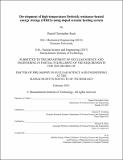| dc.contributor.advisor | Charles W. Forsberg and Michael P. Short. | en_US |
| dc.contributor.author | Stack, Daniel Christopher. | en_US |
| dc.contributor.other | Massachusetts Institute of Technology. Department of Nuclear Science and Engineering. | en_US |
| dc.date.accessioned | 2021-05-24T20:24:15Z | |
| dc.date.available | 2021-05-24T20:24:15Z | |
| dc.date.copyright | 2021 | en_US |
| dc.date.issued | 2021 | en_US |
| dc.identifier.uri | https://hdl.handle.net/1721.1/130800 | |
| dc.description | Thesis: Ph. D., Massachusetts Institute of Technology, Department of Nuclear Science and Engineering, February, 2021 | en_US |
| dc.description | Cataloged from the official PDF version of thesis. | en_US |
| dc.description | Includes bibliographical references (pages 117-121). | en_US |
| dc.description.abstract | Towards combating climate change, the widespread replacement of fossil fuel energy with zero-carbon energy has two main requirements: (1) the ability to reach very high temperatures using zero-carbon energy to perform a variety of continuous industrial processes, such as iron smelting and cement clinker production; (2) the ability to match electricity supply with demand. Firebrick resistance-heated energy storage (FIRES) is a previously proposed technology capable of meeting both requirements by storing zero-carbon electricity as high-temperature heat, and delivering it to industrial plants or power plants as needed in place of fossil fuels. The capability limits of FIRES is set by existing electrical heater options, which limit the temperatures and heat rates of the system. The work herein describes the development of a novel high-temperature FIRES system using cation-doped ceramic firebricks as the basis of the electrical heating system. | en_US |
| dc.description.abstract | The firebricks are directly resistance heated (DRH), enabling peak temperatures equal to that of flame temperatures, and allowing FIRES to electrify and decarbonize the hottest industrial processes and power the highest efficiency turbines. The fundamentals of semiconductor joule heater design were reviewed, and the material option space was evaluated. Chromia doped with nickel was identified as a promising material candidate for a DRH-style FIRES system. Commercial and doped lab-fabricated chromia samples were prepared. Electrical resistivity was measured as a function of temperature, and brick-brick contact resistivity was measured as a function of temperature and contact load, up to 1500°C, to determine viability of electrically heating a freely stacked brick mass. A proof of concept of DRH was successfully demonstrated by electrically heating a small stack of doped samples. | en_US |
| dc.description.abstract | Calculations and simulations of brick-brick contact temperature rise, short circuit failure conditions, and thermal runaway were developed and undertaken using the experimentally measured electrical properties and the expected operating conditions of a FIRES system as inputs. Results informed the development of an electrically conductive brickwork design, including the brick dimensions and patterns of interlaid insulative and conductive firebrick to form an electrical circuit resistant to thermal runaway. The bricks and brickwork were designed with the intention of being compatible with hot blast stoves (heat regenerators) commonplace in the steel industry to provide a pathway for commercial development using existing industrial experience. Specific modifications necessary for coupling FIRES with blast furnaces, cement kilns, and gas turbines were explored. | en_US |
| dc.description.statementofresponsibility | by Daniel Christopher Stack. | en_US |
| dc.format.extent | 121 pages | en_US |
| dc.language.iso | eng | en_US |
| dc.publisher | Massachusetts Institute of Technology | en_US |
| dc.rights | MIT theses may be protected by copyright. Please reuse MIT thesis content according to the MIT Libraries Permissions Policy, which is available through the URL provided. | en_US |
| dc.rights.uri | http://dspace.mit.edu/handle/1721.1/7582 | en_US |
| dc.subject | Nuclear Science and Engineering. | en_US |
| dc.title | Development of high-temperature firebrick resistance-heated energy storage (FIRES) using doped ceramic heating system | en_US |
| dc.type | Thesis | en_US |
| dc.description.degree | Ph. D. | en_US |
| dc.contributor.department | Massachusetts Institute of Technology. Department of Nuclear Science and Engineering | en_US |
| dc.identifier.oclc | 1252204287 | en_US |
| dc.description.collection | Ph.D. Massachusetts Institute of Technology, Department of Nuclear Science and Engineering | en_US |
| dspace.imported | 2021-05-24T20:24:15Z | en_US |
| mit.thesis.degree | Doctoral | en_US |
| mit.thesis.department | NucEng | en_US |
